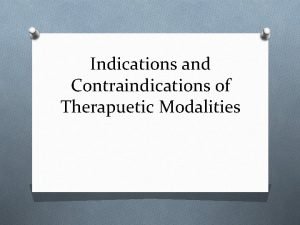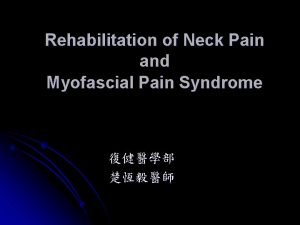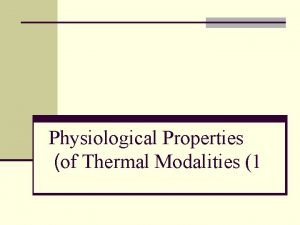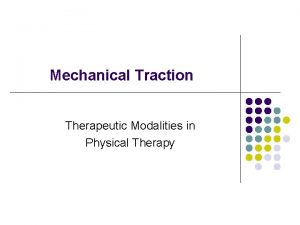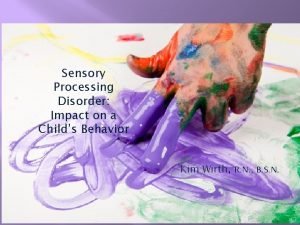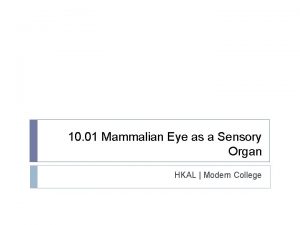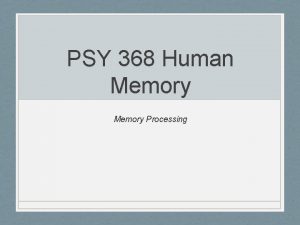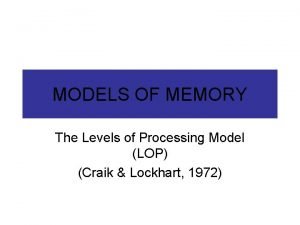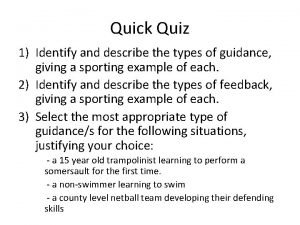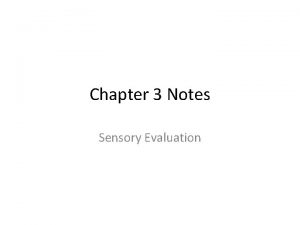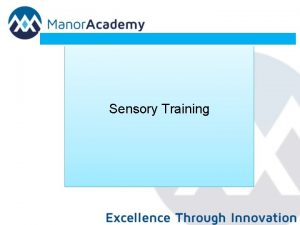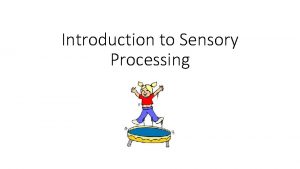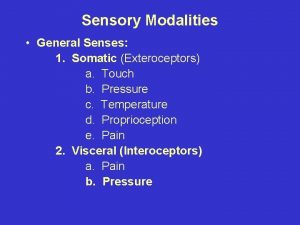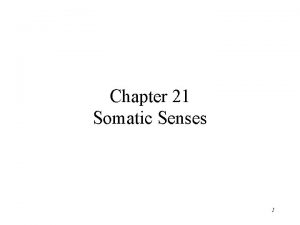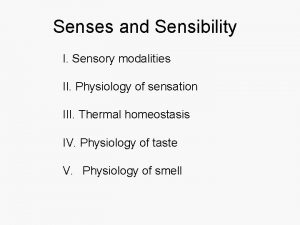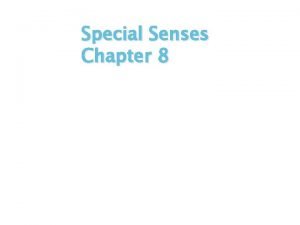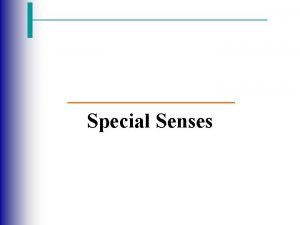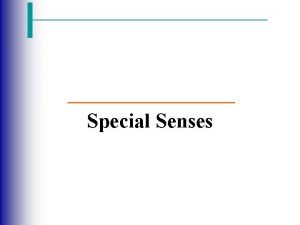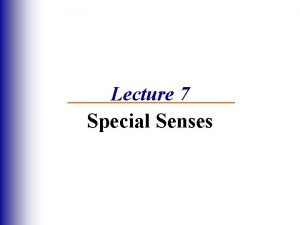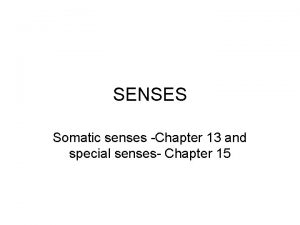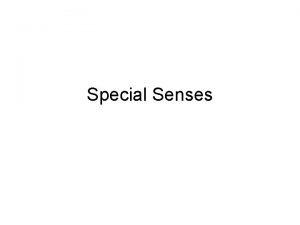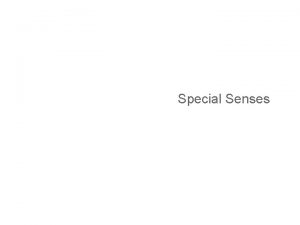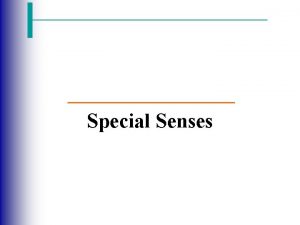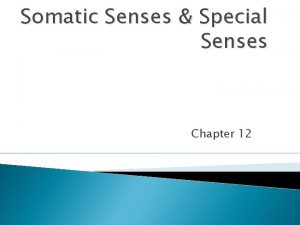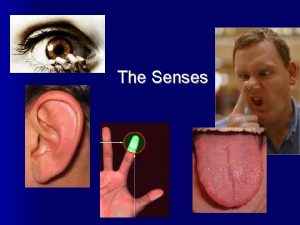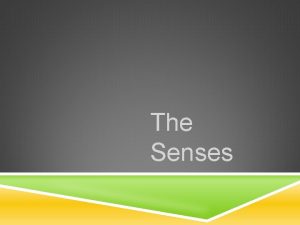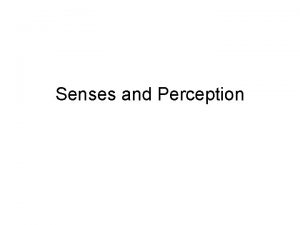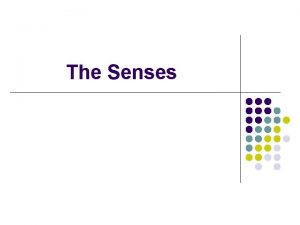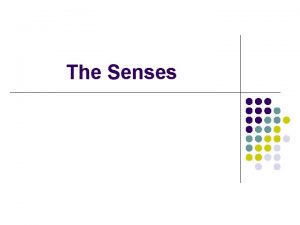Senses Sensory modalities in human Sensory processing Levels































- Slides: 31

Senses

Sensory modalities in human

Sensory processing Levels of organization uderlying sensory processing: I. Receptors II. Sensory circuits and pathways III. Sensory perception

Receptors stimulus transduction of the sensory stimuli impulse initiation

Receptor potential in a muscle stretch receptor (mechanoreceptor). A. These receptors signal muscle length and the speed at which the muscle is stretched. The sensory fiber nerve endings respond to stretch of the muscle fibers. Mechanical deformation of the membrane opens the stretchsensitive ion channels. The influx of Na+ and Ca 2+ depolarizes the nerve ending, producing the receptor potential. B. Upper records: depolarizing receptor potentials recorded from the sensory axon (APs have been blocked with TTX) when the muscle spindle is stretched to different lengths. Lower records: amplitude and rate of stretch. The initial depolarization of the receptor in response to change in muscle length (dynamic response) is proportional to both the rate and amplitude of stretch. When stretch is maintained, the receptor potential decays to a lower value proportional only to the amount of stretch (static response). C. Patch clamp records of a single stretch-sensitive channel. As the pressure on the membrane is increased, the channel opens more often and remains in the open state for longer time intervals.

Stimulus encoding Receptor potential and impulse frequency exhibit close correlation. Stimulus intensity Intensity coding in skin touch receptors. Left: in slowly adapting mechanoreceptors the firing rate is higher at the beginning of skin contact than during steady pressure. Right: rapidly adapting mechanoreceptors respond only at the beginning and end of the stimulus, signaling the rate at which the stimulus is applied or removed. The receptor is silent when the indentation is maintained at a fixed amplitude. Firing rate

Hierarchical information processing Basic rules: I. Divergence II. Converrgence III. Parallel processing IV. Feedback

Connections Connection patterns between neurons: a) Converrgence b) Divergence c) Serial processing d) Parallel processing e) Selfeedback f) Excitatory positive feedback g) Inhibitory positive feedback h) Negative feedback

Synaptic triad: input elements, relay neurons, intrinsic neurons,

Microcircuits Examples of synaptic triads in sensory systems. There are input elements (the receptors) and output neurons (A; ganglion cells, B: mitral cells). There are interneurons for straight-through transmission and there are interneurons for horizontal interactions. The horizontal connections are organized at two levels. In both cases there is provision for straight-through transfer of signals to the output neuron and local processing of signals through the interneurons.

Lateral inhibition Pattern of activity in population of ganglion cells in response to light – dark edge stimulus. The enhancement of response on the light side of the edge and depression on the dark side are due to inhibitory interactions at the level of biopolar cells and horizontal cells (not shown in the picture).


The Cafe Wall illusion

The Cafe Wall illusion The original of the Café Wall, St Michael's Hill, Bristol.

The Cafe Wall illusion The part of the line indicated by an violet circle is surrounded by a large white region. These areas will be dimmed in the retina. The part of the line indicated by a orange circle is surrounded by dark regions, and will be slightly brightened in the retina. The result is that each line acquires a slight diagonal striping, which develops into converging slopes. http: //www. positscience. com/brain-resources/brain-teasers/cafe-wall-illusion

Representation of sensory modalities in the human brain Inputs from different sensory organs are processed in different areas in the brain. Information from different senses is integrated in associational cortices, which occupy large cortical areas.

Sensory perception: detection Modality Threshold Vision Intensity: 1 photon (energy: 3 x 10 -19 J; energy of small apple falling: 1 J ) Wavelength: 400 nanometers Audition Movement of eardrum: 10 -8 cm (diameter of the hydrogen atom ) Olfaction Ethyl ether: 5. 83 mg/liter of air Artificial musk: 0. 00004 mg/liter of air Taste Sucrose (sweet): 7 g/liter Na. Cl (salty): 2 g/liter Quinine sulfate (bitter): 0. 00015 g/liter Somesthesia Pressure (back of hand): 12 g/mm 2 Pain (back of hand): 100 g/mm 2

Stimulus - response relationship • Equal changes in strength do not produce equal change in sensations. • For most senses (vision, audition) the relationship is logarithimic (equal percentage changes in stimulus strength result in equal changes in response). It expands the range of possible stimuli. • For some senses (e. g. , temperature) the relationship is power law. The range of stimulus values is smaller but extreme values are sensed more strongly. Brightness of light red green Lifted weight Angle between two surfaces felt with hands Warmth

Rules of perception • Gestalt (germ. configuration or form) psychologists identified principles of perception. They proposed that the human senses perceive objects in as a whole before perceiving their individual parts, suggesting the whole is greater than the sum of its parts. • Perception depends not only on the properties of the stimulus element but also on its interaction with other elements simultaneously present. (We recognize relationships, not the components). • The brain makes certain assumptions about what is to be experienced. They derive in part from the experience and in part from built-in neural wiring. • Perception is not gaining an objective impression of the world around us but it is a creative act of the mind.

Pattern recognition I

Pattern recognition II The array of identical dots in A is ambiguous and can be seen alternatively as a pattern of columns or rows. Dots in B, C are not ambiguous because of additional cues (B – colors, C - proximity).

Figure – ground recognition Brain identifies part of the scene as a recognizable object and considers other parts as background. This process can by dynamic. Bistable figures. As we focus on one pattern, the rest is relegated to the background. Perception alternates between two different possible percepts.

Filling-in Brain is able to interpolate shape and structure from fragmented information. It can fill-in information that is not directly given in the sensory input. The Kanizsa triangle. A triangle is perceived in the center of each drawing even though the outline of the triangle does not exist in the drawing and must be inferred from fragments of other objects in the drawing. A white triangle emerges from a white background a black triangle from a black background.

Comparison to surroundings Brain uses spatial relationships of objects to help to interpret image, e. g. , it compares object to surroundings to judge its size. Left: Both women appear to be the same size. Right: The second woman seems small, because the corridor and tiles around her are not proportional, as they are in the photo at left.

Knowledge-based inference Perception is based on what we know about our world. This information is built into the wiring of the brain by genetic and developmental mechanisms. Do we see spheres or cavities? We always assume the light source to be above. By reversing the image one can reverse the depth of these objects.

Knowledge-based inference Perception is based on what we know about our world. This information is built into the wiring of the brain by genetic and developmental mechanisms. Do we see spheres or cavities? We always assume the light source to be above. By reversing the image one can reverse the depth of these objects.

Knowledge-based inference Brain assumes that closer structures cover those that are more distant. It can “see” a pattern in otherwise unrelated shapes only when the shapes are seen as fragments of an covered background.

Knowledge-based inference Brain assumes that closer structures cover those that are more distant. It can “see” a pattern in otherwise unrelated shapes only when the shapes are seen as fragments of an covered background.

Perception – dependence on experience The silence of the lambs poster

Perception – dependence on experience The silence of the lambs - poster detail The silence of the lambs poster

Perception – dependence on experience The silence of the lambs - poster detail The silence of the lambs poster Salvador Dali In Voluptas Mors, 1951
 Distinguish between general senses and special senses.
Distinguish between general senses and special senses. General senses vs special senses
General senses vs special senses Chapter 41 musculoskeletal care modalities
Chapter 41 musculoskeletal care modalities Superficial and deep heating modalities
Superficial and deep heating modalities Thermotherapy indications
Thermotherapy indications Cervical hivd
Cervical hivd Thermal modalities
Thermal modalities Mechanical modalities
Mechanical modalities Human senses in hci
Human senses in hci Sensory processing disorder dsm
Sensory processing disorder dsm Types of autism spectrum disorder dsm 5
Types of autism spectrum disorder dsm 5 Sequence of sensory processing
Sequence of sensory processing Costa's levels of thinking examples
Costa's levels of thinking examples Levels of processing theory
Levels of processing theory Level of processing
Level of processing Levels of processing theory
Levels of processing theory Levels of processing
Levels of processing Sensory evaluation the human factor
Sensory evaluation the human factor Sensory evaluation the human factor
Sensory evaluation the human factor The thinness or thickness of a product
The thinness or thickness of a product Top.down processing
Top.down processing Bottom up processing vs top down processing
Bottom up processing vs top down processing Bottom-up processing example
Bottom-up processing example Point processing operations
Point processing operations Secondary processing
Secondary processing What is point processing in digital image processing
What is point processing in digital image processing Histogram processing in digital image processing
Histogram processing in digital image processing Parallel processing vs concurrent processing
Parallel processing vs concurrent processing Neighborhood processing in digital image processing
Neighborhood processing in digital image processing Point processing
Point processing Digital image processing
Digital image processing Top down procesing
Top down procesing




